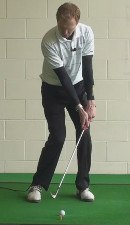
Pinching the Ball in Golf
Golf, known for its unique terminology and technicalities, has a term called “pinching the ball.” This term refers to a specific action that golfers take in order to control the flight and spin of the golf ball during impact with the clubface. Let's delve deeper into this concept:
- Pinching the ball is primarily concerned with imparting backspin on the golf ball, allowing it to stop or even back up on the green once it lands.
- It is an advanced technique that requires precise execution and a good understanding of the club dynamics and impact dynamics.
- Importance of Pinching: Controlling the backspin helps golfers achieve better distance control, accurate approach shots, and the ability to hold the ball on sloping greens.
Now, let's explore the steps involved in pinching the ball:
- Correct Ball Position: Begin by ensuring the ball is positioned correctly in your stance. For most iron shots, the ball should be located slightly ahead of the center of your stance. This position promotes a slightly descending strike on the ball, which is crucial for generating backspin.
- Forward Shaft Lean: To create the desired downward strike, establish a forward shaft lean at address. This means having your hands slightly ahead of the clubhead, ensuring that the clubface is in a slightly delofted position.
- Smooth and Controlled Swing: During the swing, focus on a smooth and controlled motion. Avoid excessive wrist action or scooping at impact, as these can lead to inconsistent strikes and reduced backspin.
- Descending Strike: As you make contact with the ball, ensure that your clubhead strikes the ball before the club reaches the lowest point of its arc. This downward strike compresses the ball against the ground, creating a crisp impact that maximizes backspin potential.
- Ball Compression: Squeezing the ball against the clubface at impact is vital for generating backspin. Visualize pinching the ball between the face of the club and the ground as you make contact. This compression promotes spin and helps the ball climb the clubface, creating the desired spin effect.
- Follow-Through: After impact, maintain a balanced and controlled follow-through. Avoid decelerating the clubhead abruptly, as it can affect the amount of spin generated.
Common Mistakes to Avoid:
- Failure to control clubhead speed can cause excessive spin or reduce spin altogether. Maintaining a consistent swing tempo is crucial.
- Gripping the club too tightly can limit the natural action of the clubface, resulting in reduced spin. Maintain a relaxed but firm grip throughout the swing.
- Incorrect shaft angle at impact can lead to inconsistent spin generation. Practice achieving the correct forward shaft lean and clubface angle for optimal results.
- Not practicing enough. Like any golf skill, pinching the ball requires practice and experimentation. Regularly dedicate time to this aspect of your game to improve your proficiency.
Remember, pinching the ball is an advanced technique that may take time to master. So be patient, practice regularly, and gradually incorporate it into your game. With dedication and practice, you'll be able to control the flight and spin of your golf ball, improving your overall performance on the course.





